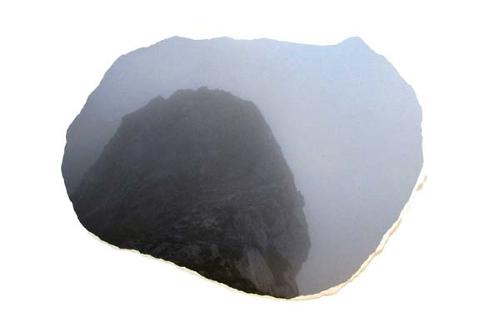
Foundations Edge: Artists and Technology is an exhibition of 6 artists who are interested in the technology that fills the world around them, with a particular emphasis on the dismantling, rebuilding and reinventing of items that are usually taken for granted, such as mobile phones, digital cameras and computer programs. Together the works in the exhibition display great variety; some are grandiose in colour and form, some are interactive, while others are a quietly intriguing mix-up of discarded technology. Together, however, they become an introspective exploration of the mechanisms within a wide range of everyday objects, raising questions about the role of human interaction with technology.
The modification of technology to serve a new or altered purpose is a recurring theme highlighted in Benjamin Forster's Drawing Machine (output plotter). In entering the room, one’s attention is immediately drawn to whirring, scratching mechanical sounds coming from a plotter sketching obscure lines onto an enormous roll of paper with a furious determination. It draws through software programming, but unlike its conventional usage for highly detailed plans and designs, Drawing Machine (output plotter) continuously draws its own designs. The results are interspersed with fragments of text, and look as much like a child’s drawing as they recall the ancient elegance of the Nazca lines.
Interaction also features in Forster’s work. In Short Message Service (2012) a number of loosely wired parts of circuitry lie dormant, until the viewer sends a text message to a number as instructed by the didactic. The disembodied yet functional mobile phone blips, and sends a reply in the form of a randomly generated, character-based text pattern.
In a black room, a series of ornate chandeliers hang enveloped by blackness. They float in a depth of silence, their intricate rows of hanging crystal beads emanating an iridescent green against the purple haze of black lights. Evoking at times the forms of deep-sea jellyfish and then the ancient furnishings of a haunted house, their eerie presence gives the impression that they belong to a void-like world without depth or breadth or time. This may well be the effect that Ken & Julia Yonetani are looking for with their Crystal Palace: The great exhibition of the works of industry of all nuclear nations (2012). The chandeliers are constructed from beads of uranium glass, a substance that glows under common black lights to emit a luminescent green. The name itself is a reference to the Crystal Palace, an enormous building constructed in 1851 to showcase the technological advancements of the industrial revolution. Crafted as a response to the 2011 Fukushima nuclear disaster, the work pointedly questions the validity of a nuclear-powered future, suggesting a future as fragile as the Crystal Palace.
In Heavy Nothing (2012), Lawrence English, a composer and media artist constructs record plates of obscure and obsolete materials such as copper and mirrored vinyl. They sit on conventional turntables, but instead of playing music they play the indecipherable whisperings of the manufacturing process to draw our attention to the act of considered listening. And the resulting effect is striking - the effort of making out the sound of the record in turn renders every sound in the gallery audible.
However, not all the works draw the same level of engagement or interest as the work by Ken & Julia Yonetani or Benjamin Forster. Light Render by Caitlan Franzman uses the viewer’s own body within the artwork, it is filmed and projected onto the wall behind a hanging wooden cube for the duration of his or her presence in the space. Although the project succeeds as an immersive exploration of light, space and dimension, viewers may be inclined to not give the work enough consideration to fully grasp its meaning due to its inherently simple modes of operating and casual aesthetic.
Another artist particularly known for his use of re-invented technology is Michael Candy. Using old discarded camera parts, Candy has constructed a functional 3-megapixel camera called Frank (2010), a reference to the iconic monster created by Dr Frankenstein. The photos taken with the camera look much like today’s smart-phone photo modification applications such as instagram, where the subject is less important than the mood or aestheticised appearance of the 'vintage’ styled photographs. As a playful creator, Candy excels in engineering fantastic pieces that stand apart in their field; however Frank may have been much more interesting if the process of the creative efforts had been incorporated as an element in the final resolution of the work.
The selection and display of the works establish a quiet austere exhibition experience that is a refreshing change from what appears to be something of a trend towards clamour and ‘chatter’ that has come to represent so many exhibitions of new media art.












